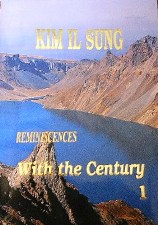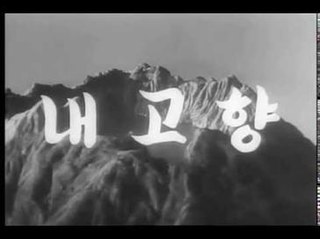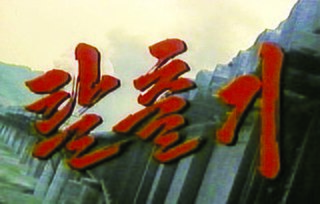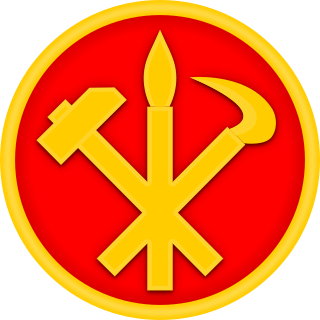
Juche, officially the Juche idea, is the state ideology of North Korea and the official ideology of the Workers' Party of Korea. North Korean sources attribute its conceptualization to Kim Il Sung, the country's founder and first leader. Juche was originally regarded as a variant of Marxism–Leninism until Kim Jong Il, Kim Il Sung's son and successor, declared it a distinct ideology in the 1970s. Kim Jong Il further developed Juche in the 1980s and 1990s by making ideological breaks from Marxism–Leninism and increasing the importance of his father's ideas.

The contemporary culture of North Korea is based on traditional Korean culture, but has developed since the division of Korea in 1945. The Juche ideology conceived by Kim Il Sung (1948–1994) asserts Korea's cultural distinctiveness and creativity, as well as the productive powers of the working masses.

Pyongyang: A Journey in North Korea is a black-and-white graphic novel by the Canadian Québécois author Guy Delisle, published in 2003. The novel details the months Delisle spent in Pyongyang while working for a French animation company.
Korean April 26 Animation Studio, also known as SEK Studio, is a state-owned North Korean animation studio, based in Ot'an-dong, Central District, Pyongyang.

The Down-with-Imperialism Union was allegedly founded on 17 October 1926 in Hwatian County, Kirin, China, in order to fight against Japanese imperialism and to promote Marxism–Leninism. It is considered by the Workers' Party of Korea to be its root and foundation and its creation is celebrated every year.

Shin Sang-ok was a South Korean filmmaker with more than 100 producer and 70 director credits to his name. His best-known films were made in the 1950s and 60s, many of them collaborations with his wife Choi Eun-hee, when he was known as "The Prince of South Korean Cinema". He received posthumously the Gold Crown Cultural Medal, the country's top honor for an artist.

Sea of Blood is a propagandist North Korean opera credited to Kim Il Sung. It was first produced as an opera by Sea of Blood Theatrical Troupe in 1971. It was then later adapted into a novel by the Choseon Novelist Association of the 4.15 Culture Creation Group in 1973.

Kim Il Sung Square is a large city square in the Central District of Pyongyang, North Korea, and is named after the country's founding leader, Kim Il Sung. The square was constructed in 1954 according to a master plan for reconstructing the capital after the destruction of the Korean War. It was opened in August 1954. The square is located on the foot of the Namsan Hill, west bank of the Taedong River, directly opposite the Juche Tower on the other side of the river. It is the 37th largest square in the world, having an area of about 75,000 square metres which can accommodate a rally of more than 100,000 people. The square has a great cultural significance, as it is a common gathering place for concerts, rallies, dances and military parades and is often featured in media concerning North Korea.

The Workers' Party of Korea (WPK) is the sole ruling party of the Democratic People's Republic of Korea, commonly known as North Korea. Founded in 1949 from a merger between the Workers' Party of North Korea and the Workers' Party of South Korea, the WPK is the oldest active party in Korea. It also controls the Korean People's Army, North Korea's armed forces. The WPK is the largest party represented in the Supreme People's Assembly and coexists with two other legal parties that are completely subservient to the WPK and must accept the WPK's "leading role" as a condition of their existence. The WPK is banned in the Republic of Korea under the National Security Act and is sanctioned by the United Nations, the European Union, Australia, and the United States.

Propaganda is widely used and produced by the government of the Democratic People's Republic of Korea. Most propaganda is based on the Juche ideology, the promotion of the Workers' Party of Korea, and hostilities against both the Republic of Korea and the United States

Reminiscences: With the Century is the autobiography of Kim Il Sung, founder and former president of North Korea. The memoirs, written in 1992 and published in eight volumes, retell Kim's life story through his childhood to the time of Korean resistance. Initially, a total of 30 volumes were planned but Kim Il Sung died in 1994 after just six volumes; the seventh and eight volumes were published posthumously. The work reveals early influences of religious and literary ideas on Kim's thinking. An important part of North Korean literature, With the Century is held as a valuable if unreliable insight into the nation's modern history under late colonial Korea. The book is considered one of a few North Korean primary sources widely available in the West and as notable research material for North Korean studies.

My Home Village is a 1949 war film directed by Kang Hong-sik. It is the first feature film to be made in North Korea after its 1948 establishment. The film portrays the liberation of Korea from Japanese colonial rule in 1945.

On the Art of the Cinema is a 1973 treatise by the North Korean leader Kim Jong Il. It is considered the most authoritative work on North Korean filmmaking.

On the Juche Idea is a treatise attributed to North Korean leader Kim Jong Il on the North Korean Juche ideology. It is considered the most authoritative work on Juche.

Kim Il Sung and Kim Jong Il badges are lapel pins with portraits depicting either one or both of the Eternal Leaders of North Korea, Kim Il Sung and Kim Jong Il. The badges have been common since the late 1960s, and are produced by the Mansudae Art Studio. There are more than 20 different designs, some of which are more common than others. Common examples include red flag-shaped pins depicting either Eternal President Kim Il Sung or Eternal General Secretary Kim Jong Il, smaller circular pins with the same portraits on white backgrounds, and larger flag-shaped pins depicting both leaders.

An Emissary of No Return is a 1984 North Korean historical drama film directed by Shin Sang-ok and Choi Eun-hee. It was the first of four films Shin and Choi made during their abduction to North Korea under the orders of Kim Jong Il. Adapted from Bloody Conference(혈분만국회 ), a play allegedly written by Kim Il Sung during his guerrilla years, the film retells the dramatized story of the Hague Secret Emissary Affair. The affair ensued when the Korean emperor king Gojong sent three unauthorized emissaries to the talks of the Hague Convention of 1907.

Salt is a 1985 North Korean tragedy film directed by Shin Sang-ok. It is the third of his North Korean films after he and his wife Choi Eun-hee were abducted and brought to the country against their will. Choi stars in Salt as an unnamed mother who disapproves of her son after he runs away with guerrillas, but eventually comes to see them as fighting for a just cause. The film is set in 1930s Kando (Jiandao) where ethnic Koreans are persecuted by the Chinese and Japanese.

Runaway is a 1984 North Korean melodrama film directed by Shin Sang-ok. It was Shin's second film in North Korea after he and his wife Choi Eun-hee had been abducted there. Runaway stars Choe Sang-soo as the protagonist and Choi as his wife.

The Propaganda and Agitation Department, officially translated as the Publicity and Information Department, is a department of the Central Committee of the Workers' Party of Korea (WPK) tasked with coordinating the creation and dissemination of propaganda in North Korea. It is the highest propaganda organization in the country.

Animation in North Korea began in 1948 and has been a growing industry since. Before the Korean War, the Pyongyang animation study opened in 1948. In the same year, the north region of the parallel 38th became a communist republic. From 1948 until the 1980s, Pyongyang animation studio produced more than two hundred films.






















